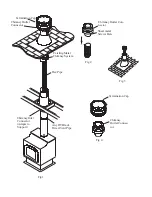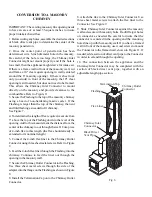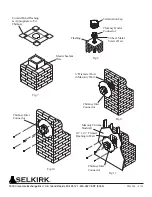
CONVERSION TO A MASONRY
CHIMNEY
IMPORTANT: The existing masonry flue opening needs
to have an area of at least 35-square inches to insure
proper intake/exhaust flow.
1. Before cutting any holes, assemble the desired sections
of black direct vent pipe to determine the center of the
masonry penetration.
2. Once the center point of penetration has been
determined, cut a 6-inch diameter hole in the masonry.
Be careful, if the hole is too large, the Chimney Inlet
Connector might not mount properly, and if the hole is
too small, then the appliance might starve for intake air.
If there is a frame wall in front of the masonry wall, cut
and frame a 10" clear square opening in wall (centered
around the 6" masonry opening). If there is sheet rock
only (no studs) in front of the masonry, the 10" clear
opening is still needed, but does not need to be framed.
This allows the Chimney Inlet Connector to mount
directly on the masonry and provide clearance to the
combustibles. Refer to Figure 11.
3. Secure the Flashing to the top of the masonry chimney
using a bead of non-hardening mastic sealer. If the
Flashing is larger than the top of the chimney, then cut
and fold flashing as needed to fit chimney.
See Figure 7.
4. To determine the length of flex required, measure from
3" above the top of the Flashing down to the level of the
opening. Add to this measurement the distance from the
center of the chimney to out through the wall. Cut a piece
of 4-inch flex to this length (the flex should already be
extended to its nominal length).
5. Connect the 4-inch flex liner to the Chimney Outlet
Connector using three sheet metal screws. Refer to Figure
2.
6. Feed the 4-inch flex liner through the Flashing into the
chimney. Continue to feed the liner out through the
opening in the masonry wall.
7. Secure the Chimney Outlet Connector to the Flashing.
Use three sheet metal screws through the side of the
adapter into the flange on the Flashing, as shown in Figure
8.
8. Install the Termination Cap on to the Chimney Outlet
Connector.
8. Attach the flex to the Chimney Inlet Connector. Use
three sheet metal screws to attach the flex liner to the
Connector. Sec Figure 9.
9. Slide Chimney Inlet Connector against the masonry
wall and secure with masonry bolts. Re-drill larger holes
on connector as needed. Be careful to insure that the
connector is centered in the opening and the mounting
holes line up with the masonry wall. If you have a framed
wall in front of the masonry, use wood screws to mount
the Connector to the framed wall, shown in Figure 11. If
needed, add a section of direct vent pipe to the Connector
in order to extend through the opening.
10. The connection between the appliance and the
Chimney Inlet Connector may be completed with the
section of black direct vent pipe, together with an
adjustable length pipe section.
Fig 6
Chimney Inlet
Connector
Flex Liner
Black Direct
Vent Pipe
Termination Top
Chimney Outlet
Connector
Flashing






















